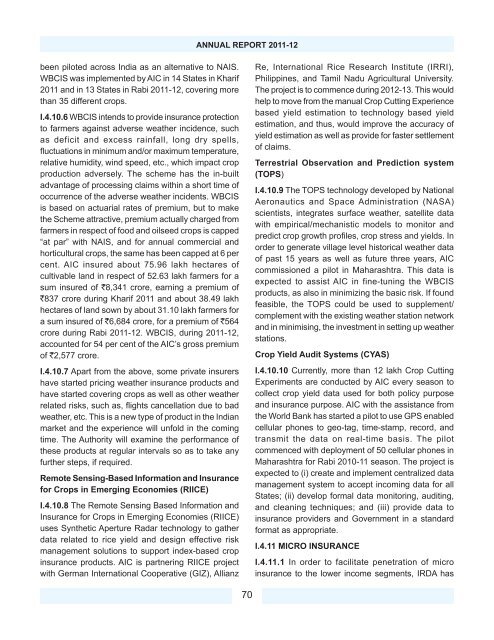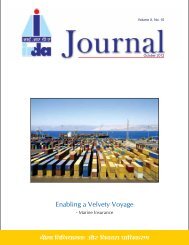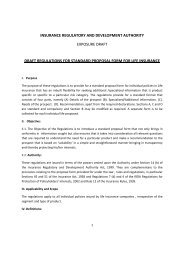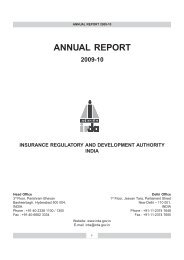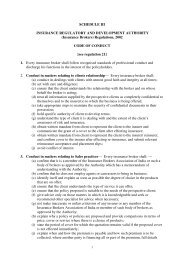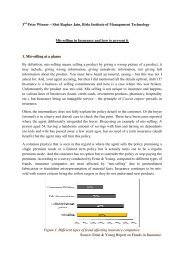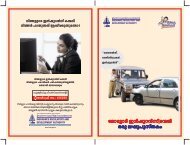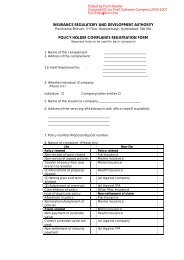Download PDF - IRDA
Download PDF - IRDA
Download PDF - IRDA
You also want an ePaper? Increase the reach of your titles
YUMPU automatically turns print PDFs into web optimized ePapers that Google loves.
ANNUAL REPORT 2011-12<br />
been piloted across India as an alternative to NAIS.<br />
WBCIS was implemented by AIC in 14 States in Kharif<br />
2011 and in 13 States in Rabi 2011-12, covering more<br />
than 35 different crops.<br />
I.4.10.6 WBCIS intends to provide insurance protection<br />
to farmers against adverse weather incidence, such<br />
as deficit and excess rainfall, long dry spells,<br />
fluctuations in minimum and/or maximum temperature,<br />
relative humidity, wind speed, etc., which impact crop<br />
production adversely. The scheme has the in-built<br />
advantage of processing claims within a short time of<br />
occurrence of the adverse weather incidents. WBCIS<br />
is based on actuarial rates of premium, but to make<br />
the Scheme attractive, premium actually charged from<br />
farmers in respect of food and oilseed crops is capped<br />
“at par” with NAIS, and for annual commercial and<br />
horticultural crops, the same has been capped at 6 per<br />
cent. AIC insured about 75.96 lakh hectares of<br />
cultivable land in respect of 52.63 lakh farmers for a<br />
sum insured of `8,341 crore, earning a premium of<br />
`837 crore during Kharif 2011 and about 38.49 lakh<br />
hectares of land sown by about 31.10 lakh farmers for<br />
a sum insured of `6,684 crore, for a premium of `564<br />
crore during Rabi 2011-12. WBCIS, during 2011-12,<br />
accounted for 54 per cent of the AIC’s gross premium<br />
of `2,577 crore.<br />
I.4.10.7 Apart from the above, some private insurers<br />
have started pricing weather insurance products and<br />
have started covering crops as well as other weather<br />
related risks, such as, fl ights cancellation due to bad<br />
weather, etc. This is a new type of product in the Indian<br />
market and the experience will unfold in the coming<br />
time. The Authority will examine the performance of<br />
these products at regular intervals so as to take any<br />
further steps, if required.<br />
Remote Sensing-Based Information and Insurance<br />
for Crops in Emerging Economies (RIICE)<br />
I.4.10.8 The Remote Sensing Based Information and<br />
Insurance for Crops in Emerging Economies (RIICE)<br />
uses Synthetic Aperture Radar technology to gather<br />
data related to rice yield and design effective risk<br />
management solutions to support index-based crop<br />
insurance products. AIC is partnering RIICE project<br />
with German International Cooperative (GIZ), Allianz<br />
Re, International Rice Research Institute (IRRI),<br />
Philippines, and Tamil Nadu Agricultural University.<br />
The project is to commence during 2012-13. This would<br />
help to move from the manual Crop Cutting Experience<br />
based yield estimation to technology based yield<br />
estimation, and thus, would improve the accuracy of<br />
yield estimation as well as provide for faster settlement<br />
of claims.<br />
Terrestrial Observation and Prediction system<br />
(TOPS)<br />
I.4.10.9 The TOPS technology developed by National<br />
Aeronautics and Space Administration (NASA)<br />
scientists, integrates surface weather, satellite data<br />
with empirical/mechanistic models to monitor and<br />
predict crop growth profi les, crop stress and yields. In<br />
order to generate village level historical weather data<br />
of past 15 years as well as future three years, AIC<br />
commissioned a pilot in Maharashtra. This data is<br />
expected to assist AIC in fine-tuning the WBCIS<br />
products, as also in minimizing the basic risk. If found<br />
feasible, the TOPS could be used to supplement/<br />
complement with the existing weather station network<br />
and in minimising, the investment in setting up weather<br />
stations.<br />
Crop Yield Audit Systems (CYAS)<br />
I.4.10.10 Currently, more than 12 lakh Crop Cutting<br />
Experiments are conducted by AIC every season to<br />
collect crop yield data used for both policy purpose<br />
and insurance purpose. AIC with the assistance from<br />
the World Bank has started a pilot to use GPS enabled<br />
cellular phones to geo-tag, time-stamp, record, and<br />
transmit the data on real-time basis. The pilot<br />
commenced with deployment of 50 cellular phones in<br />
Maharashtra for Rabi 2010-11 season. The project is<br />
expected to (i) create and implement centralized data<br />
management system to accept incoming data for all<br />
States; (ii) develop formal data monitoring, auditing,<br />
and cleaning techniques; and (iii) provide data to<br />
insurance providers and Government in a standard<br />
format as appropriate.<br />
I.4.11 MICRO INSURANCE<br />
I.4.11.1 In order to facilitate penetration of micro<br />
insurance to the lower income segments, <strong>IRDA</strong> has<br />
70


